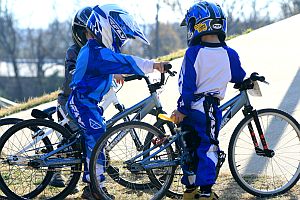Kids and Sports: The New Youth Athletics Landscape
 Over the last twenty years, the landscape of youth sports has changed dramatically. It used to be that children would gather after school and choose (or invent) an activity or game to play until dinnertime. In this world of “free play,” the kids set the rules and managed themselves more or less independently. These days, though, it’s much more common for kids’ sports to be highly organized and stratified, with adults more heavily involved than they were even a generation ago.
Over the last twenty years, the landscape of youth sports has changed dramatically. It used to be that children would gather after school and choose (or invent) an activity or game to play until dinnertime. In this world of “free play,” the kids set the rules and managed themselves more or less independently. These days, though, it’s much more common for kids’ sports to be highly organized and stratified, with adults more heavily involved than they were even a generation ago.
The downsides of adult-led, year-round structure
Kids can sometimes be rough-and-tumble, and they can also be cruel. This means that free play can have its share of problems when seen through the eyes of adults who are most concerned about limiting safety and social risks. From their point of view, there are clear advantages to having a neutral adult coach providing instruction and “managing” play. Parents who view free play as an unstructured waste of time may also be drawn to what they see as the more targeted developmental benefits of organized sports, though for slightly different reasons.
It’s important to understand that this shift has come with a cost. Many child development experts now believe that adult-led, year-round structure has deprived children of important opportunities to practice innovation, independence and self-management—including social skills like cooperation and dispute resolution. They also believe it has deprived them of opportunities to learn where the boundary is between good-natured (even competitive) physical play and play that is rough enough to cause real harm. Learning where this boundary is requires live experimentation that entails some risk. This is how children learn how to read and respond to others and to different kinds of situations appropriately.
The up-or-out world of youth athletics
The shift to adult-led, year-round structure has also changed the nature of youth athletics, creating a two-tier system of “recreational” and “competitive” sports where recreation often gets short shrift. This can produce a high-pressure environment for many children, who automatically begin associating athletics with expectations of performance. This sort of environment has the potential to change the relationship between kids and sports in a few different ways. In some cases, it may encourage youngsters of 8 or 9 years (or their parents) to choose a single sport early in their “careers” and to commit to it for the entire year. Children who do not make this early all-or-nothing commitment (even very athletic ones) may find that their playing opportunities dwindle and that they’re stuck in the middle—somewhere between a competitive tier that may demand too much and a recreational one that may offer too little. In other cases, it may discourage children with less obvious talent or less drive to abandon sports altogether.
The impact on health and wellness
This isn’t about nostalgia. It’s about long-term musculoskeletal health and fitness. For earlier generations, sports were more seasonal and it was common for kids to play several different sports throughout the year. Since they didn’t specialize until later (if at all), they tended to become more well-rounded athletes and their physical development tended to be more balanced. And to the extent that different sports require different types of movement and emphasize different muscle groups, it was less likely for a young athlete to suffer overuse injuries. Today, physicians say they are seeing more juvenile athletes come in with repetitive stress injuries. For example, a recent study from the journal Radiology revealed that young baseball pitchers are at risk of an overuse injury of the shoulder known as acromial apophysiolysis, which can lead to long-term and even irreversible consequences as kids grow.
And what about children who opt-out of sports early because of performance pressure or burnout, or because they can’t “keep up” with peers who are developing before them? It may take these children years to rediscover sports. And they may miss out on exactly the types of physical activity that keep them fit and healthy unless they find some other alternatives.
A healthier, more balanced approach to athletics
Most medical doctors and chiropractic physicians would probably agree about the importance of variety when it comes to children’s musculoskeletal health and development. Even more broadly, variety is the key to achieving balanced physical, social and psychological growth. Plus, varying your activities is a great way to prevent boredom and increase enjoyment. There’s nothing intrinsically wrong with competition or with working hard to excel at something, especially when it comes to sports and if it’s done for the love of the game. However, we adults should remember to let kids be kids, which means trying out different athletic activities, succeeding at some and failing at others, and learning to enjoy the process every step of the way.